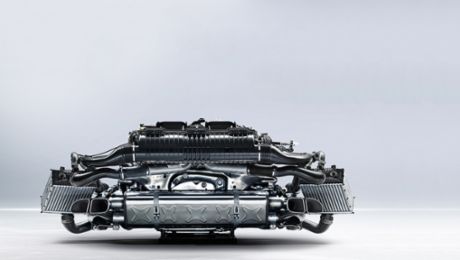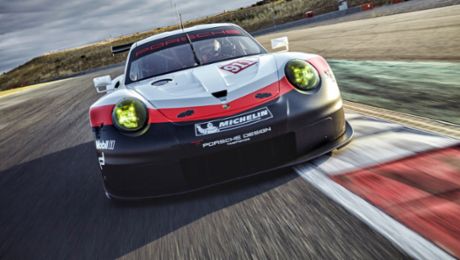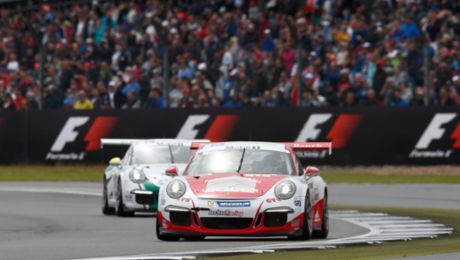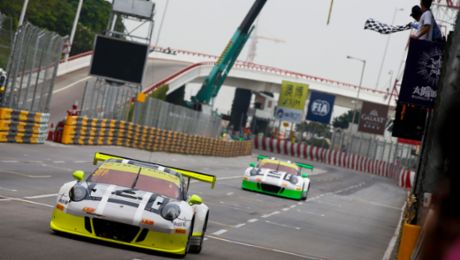In spite of all foresight, sometimes only a spirited stomp on the brake pedal will do the trick. What happens then in a Porsche impresses drivers time and again. This brute-force, almost surreal braking experience is no coincidence, but—ever since the first series Porsche with disc brakes, the 356 B Carrera 2 in 1962—Porsche philosophy in action.
“In true sports cars, the engine and brake power belong together like yin and yang,” says Donatus Neudeck, head of brakes, hydraulics, and actuation systems at Porsche. “We determine the requisite dimensions of a brake system from a variety of parameters, including the vehicle weight, axle-load distribution, acceleration power, and the top speed. Taking into account the cooling efficiency and wheel dimensions, we can then define the optimal design for the brake disc, brake caliper, and the remaining wheel brake components.”
Developed in the same way as a sports car
The goal of the developers is to provide the best braking performance and driving dynamics in the segment for every model line. That applies for the Cayenne Turbo S as well: Whether it is the brake disc dimensions and material selection, the brake cooling, the tires, or control systems, at every stage of the process, the only way to achieve a harmonious, balanced, and compelling overall package in the end result is to consider every component all the time. In this way Porsche ensures that the SUV brakes like a sports car—because it is developed in the same way as a sports car.
“The final design of the brake system derives from our fading brake cycle, which is one of the most sophisticated in the whole industry,” explains Alexander Prahst, head of development for ceramic brakes. The extreme test takes place on the high-speed circular track in Nardò, Italy, and consists of twenty brakings. The testers accelerate the car from 90 to 230 km/h. Then they hit the brakes.
“Size and weight are clearly conflicting objectives”
“After fifteen brakings, the discs reach temperatures of up to 750 degrees Celsius. To test the cooling efficiency, we let the brakes cool down to 150 degrees between the fifteenth and sixteenth brakings. With the last five brakings, we then check whether their frictional coefficient has changed or whether the brakes work with the same cool composure as at the beginning of the test,” says Prahst.
With the new 419 kW (570 hp) (Combined fuel consumption: 11,5 l/100 km; CO₂ emissions: 267 g/km) and up to 2,900-kilo (fully loaded) Cayenne Turbo S, the envelope-pushing requirements gave rise to a new dimension in brake development. It is the first high-performance SUV with ten-piston brake calipers on the front axle. In combination with the standard 420 x 40–millimeter ceramic discs with aluminum brake pots, the new development permits a drastic enlargement of the pad surface to 165 cubic centimeters. “In combination with the also new friction coating on the brake disc, it enables extremely uniform, consistently high friction,” explains Prahst.
At the same time, it was possible to reduce the weight of the brake disc from 9.8 to just under 8.5 kilograms. “Size and weight are clearly conflicting objectives. In our high-performance variants, we therefore rely exclusively on the Porsche Ceramic Composite Brake [PCCB], which reduces the unsprung masses by up to 30 kilograms and improves driving behavior,” says Prahst.
Additional conflicts: performance, noise and comfort
Moreover, the engineers designed the aerodynamics and axles to allow as much cooling air as possible into the center of the brake pot. Internally vented brake discs direct the heat via unidirectional internal cooling channels with exceptional efficiency. Neudeck illustrates just how decisive this is with an example: “When braking to a stop from top speed, the friction heat generated by the Cayenne Turbo S would suffice to boil two buckets of water in about 5 seconds.”
Performance, noise, and comfort present additional conflicts. “The vibration of the disc causes it to act like a speaker that reflects sounds.” In road use, customers do not accept the type of ambient noise tolerated while racing on a track. That’s why we work together with the manufacturers to develop pads that unite braking performance with noise requirements,” says Neudeck.
Brake development has advanced in lockstep
Aside from these differences in the details, brake development in motor racing and Porsche series vehicles has advanced in lockstep, beginning with the aforementioned first series-standard disc brakes in 1962, which originated in the Porsche 804 Formula 1 race car. In 1977, for example, the 911 Turbo (Type 930) took on virtually unmodified the brake system of the 917/30 endurance race car from 1973 (see “The World Is a Disc”).
“Porsche will not budge one millimeter from its demanding brake strategy”
Another step towards greater brake power was marked by the axially mounted aluminum fixed caliper, which became the standard of the 964 (from 1988) and 993 (from 1993) generations of the 911. The use of 17-inch wheels in the 964 enabled a major up-sizing of the brake system. The technology was once again driven by the racing department.
In the Group 5 Porsche 935, the one-piece brake caliper with bolt-supported brake pads was used as far back as 1976. In the 993, the diameter of the front brake discs grew once again: to 304 millimeters in the standard models and 322 millimeters in the Turbo. The maximum brake pressure exceeded 1.2 g even back then. Today the front and rear discs in the standard 911 measure 330 millimeters.
Different brakes - Different colors
The different Porsche brakes can be recognized by the colors of the brake calipers. The standard versions are black; the S brake calipers are either silver or red, depending on the model; and the PCCB brakes are yellow. As for the size, disc sizes over 420 millimeters are too large for a 20-inch wheel, and that’s the threshold for the Cayenne Turbo S as well—due to the chain clearance on 20-inch winter wheels. So where is development heading now?
“Porsche will not budge one millimeter from its demanding brake strategy in the future,” promises Neudeck. “The trend towards lighter vehicles plays into our hands, and hybridization is also taking pressure off the brakes to a greater degree than some had expected. In races with the 911 GT3 R Hybrid, we’ve noticed that pad and disc wear are reduced by up to 50 percent.” But new challenges are waiting.
After 2021, the use of copper in brake pads will be prohibited in the United States. At present, the copper content in brake pads is up to 35 percent—thanks to its high heat absorption and homogeneous dispersion, the material has played a major role in high-performance brake pads to date. “We essentially had to start from scratch on that point,” says Neudeck. “We’ve now found some very interesting alternatives, however, and will likely fulfill the new standards well ahead of time.” The next brake highlight from Porsche is in the works.
Info
Text first published in the Porsche customer magazine Christophorus, No. 371
By Christoph Reifenrath // Photos by Rafael Krötz
Consumption data
Cayenne Turbo S: Combined fuel consumption: 11,5 l/100 km; CO₂ emissions: 267 g/km




